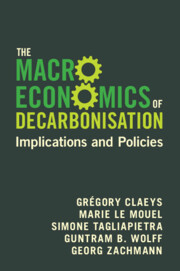Book contents
- The Macroeconomics of Decarbonisation
- Reviews
- The Macroeconomics of Decarbonisation
- Copyright page
- Contents
- Figures
- Tables
- Boxes
- Introduction
- 1 Understanding Deep Decarbonisation over the Long Run
- 2 Understanding Decarbonisation’s Short-Term Disruptions to Economic Activity
- 3 The Distributional Effects of Climate Policy
- 4 Public Finances and Decarbonisation
- 5 Greening Innovation, Industrial and Competition Policies
- 6 Mobilising the Financial System for Decarbonisation
- 7 Decarbonisation and Labour Markets
- 8 Greening Central Banks
- Conclusions
- Index
- References
Conclusions
The Macroeconomics of Decarbonisation – Between Degrowth and Green Growth
Published online by Cambridge University Press: 01 February 2024
- The Macroeconomics of Decarbonisation
- Reviews
- The Macroeconomics of Decarbonisation
- Copyright page
- Contents
- Figures
- Tables
- Boxes
- Introduction
- 1 Understanding Deep Decarbonisation over the Long Run
- 2 Understanding Decarbonisation’s Short-Term Disruptions to Economic Activity
- 3 The Distributional Effects of Climate Policy
- 4 Public Finances and Decarbonisation
- 5 Greening Innovation, Industrial and Competition Policies
- 6 Mobilising the Financial System for Decarbonisation
- 7 Decarbonisation and Labour Markets
- 8 Greening Central Banks
- Conclusions
- Index
- References
Summary
The Conclusion closes the book by going back to the opening question: given all the complexities entailed in the process, is it realistic to expect the world to be able to decouple economic growth from GHG emissions in time to save the planet, and by avoiding negative repercussions on our economies and societies? The Conclusion first discusses how the economic literature has so far tackled this question – namely presenting degrowth and green growth theories – and then illustrates the authors’ views on this.
- Type
- Chapter
- Information
- The Macroeconomics of DecarbonisationImplications and Policies, pp. 315 - 327Publisher: Cambridge University PressPrint publication year: 2024



